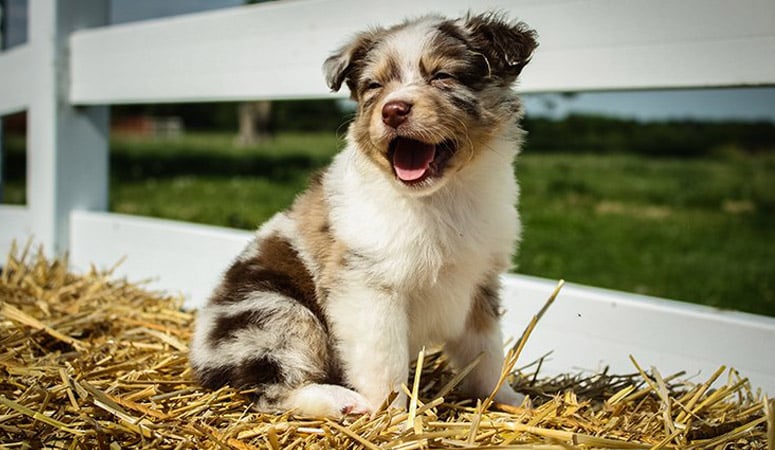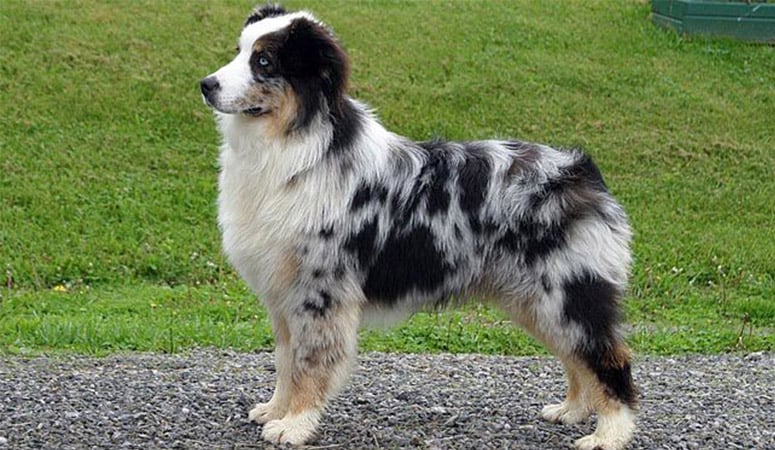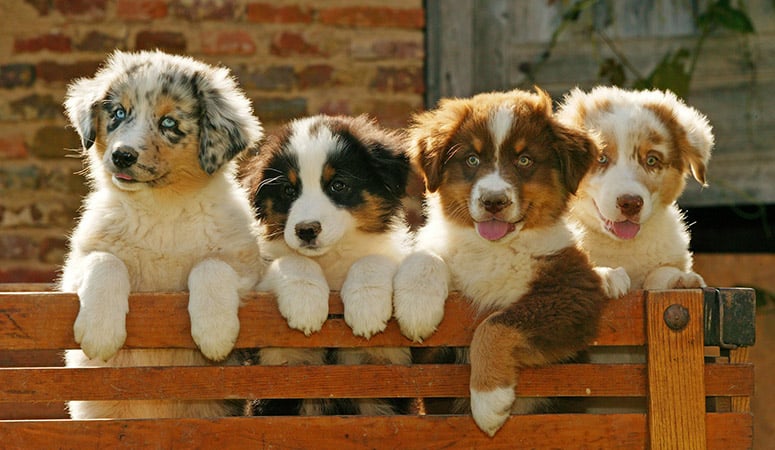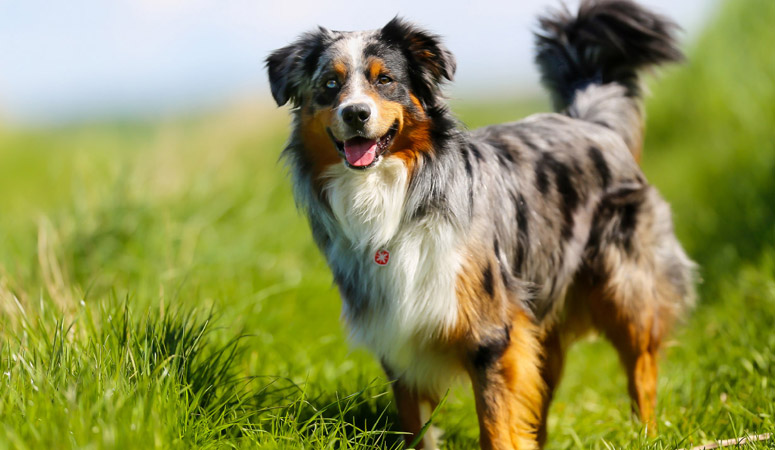Australian Shepherd
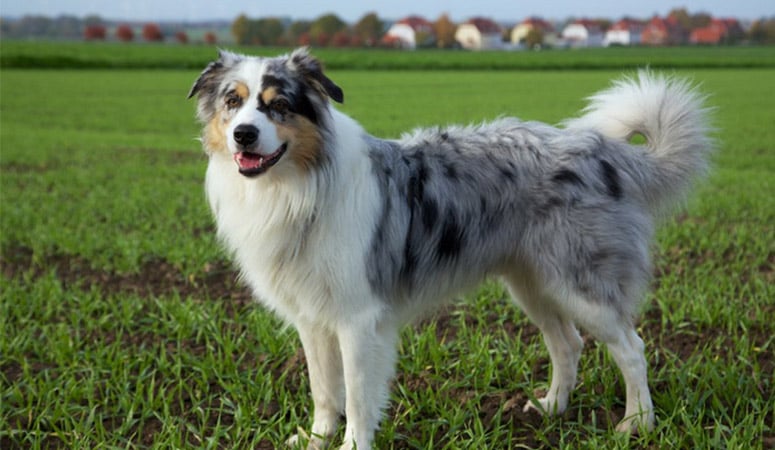
The Australian Shepherd, also known as the “Aussie”, is originated in the western United States, despite their name. They are flexible, agile, and slightly longer than its height, in medium size and bone, and they are loving, smart, independent, bold and responsible. If their intelligence and energy are guided to dog sports or activities, they could become great family partners.
| Other Names | Aussie |
| Color | Black, Blue Merle, Red, Red Merle |
| Height | Males: 20-23 inches. Females: 18-21 inches. |
| Weight | Males: 50-65 pounds. Females: 40-55 pounds. |
| Life Span | 12-15 years |
| Personality | Smart, Work-Oriented, Exuberant |
| Exercise | Energetic |
| Origin |
| Popularity | #13 |
| Groom Needs | Weekly |
| Kids Friendly | Yes |
| Dog Friendly | Yes with supervision |
| Watch Dog | Yes |
| Family Dog | |
| Litter Size | 5-10 |
Australian Shepherd Pictures
Australian Shepherd Video
Introduction
An Australian Shepherd is similar in appearance to an English Shepherd and a Border Collie in their bi- and tri-colored coats showing shades of black, tan, blue, or red. But unlike the others, the Aussie (another name for the Australian Shepherd) coat may twist and curl as much as it can be straight too. Mind you, the Aussie is built slightly bigger than the English breed.
Considered the 17th most popular dog breeds in the U.S, Australian Shepherds have been recognized as herd dogs with clear distinction. In fact, Aussies are reputable cowboy dogs. Their willingness to serve and be trained makes for a good work-dog. Added to a keen vision and sophisticated intelligence, the Aussie has all the trappings of any versatile and highly adaptable dog breed.
A standard Australian Shepherd male moves in a lean frame as high as 22 inches and weighs in the range of 50-65 pounds. In the fashion of most dog breeds, a female Aussie is equally a few points short of the size of the male. At a shoulder height of around 20 inches, she packs a robust 40-55 pound-weight in her frame.
Australian Shepherds are herd dogs, which makes them potential workaholics with incredible energy. Even at that, they can survive the stressful work-life and reach an average lifespan of 14 years.
Living with Australian Shepherd
The Australian Shepherd has medium-length coats that shed heavily, especially in the season change days. In order to keep shedding under control and mats from forming in their coat, the Australian Shepherd should be brushed once a week and several times a week during the period of large shedding. During the shedding season, more grooming work would be needed. You can use an undercoat rake to remove their dead hair every two or three times a week, then use a wire brush to clean up.
This breed is inherently cleaner, so you only need to take your dog a bath as needed when it is dirty or begins to emit odors.
It can help the Australian Shepherd prevent painful splitting, cracking, or broken nails if owners trim their nails regularly, also, checking and cleaning their ears regularly are necessary to help prevent ear infection.
Because the Australian Shepherd is always in high-energy and athletic, he needs plenty of exercise on a daily basis, and the dog should have a large fenced yard, running at least an hour or two every day, without enough activity, the Aussie can become high-strung, destructive, or snappy. They closely connected with their owner and is willing to accompany them on long walks or better hikes.
Once the Australian Shepherd loses his puppy’s character and his skeletal system is fully formed, he can become an excellent running companion. However, the best way is to give them a job, whether it is to herd livestock, shepherding children, or participate in dog competitions like obedience, herding or agile trials, or diving.
Australian Shepherd dogs should be fed two meals per day, with a maximum of 1.25 cups of dry dog food per meal. The number will depend on your dog’s size, activity level, age and other factors. Make sure to monitor your dog’s weight and resolve any overweight trends. Discuss the nutritional needs of your dog with your veterinarian to obtain appropriate advice.
For Australian Shepherds, food protection behavior is not common, but children should never be allowed to touch or remove food while any dog is eating.
Some dogs are easily overweight, so pay attention to the dog’s calorie consumption and weight level. Treats may be an important aid in training, but excessive intake can lead to obesity.
Although the Australian Shepherd is a relatively healthy dog breed, they may be prone to specific dog breed health issues, such as hip dysplasia, epilepsy, cataracts and certain forms of cancer.
Minor concerns: CHD, nasal solar dermatitis, Pelger-Huet syndrome, iris coloboma, CEA, hypothyroidism
Major concerns: cataract, CEA
Occasionally seen: lumbar sacral syndrome, epilepsy, PRA, distichiasis, elbow dysplasia
Suggested tests:
Hip Evaluation
Elbow Evaluation
Ophthalmologist Evaluation
Read the Official Breed Club Health Statement.
Total Annual Cost: $3150
Cost is estimated for the first year and may vary depending on many factors, such as dog food, health care, leash, collar, licensing, possible fencing, crates, training and obedience classes, dog-walking, grooming, treats, toys, flea, tick, and heart-worm meds, microchips, etc.
Aussies have a strong bond with their families, so they may overprotect the property of their owners in the territory, and they may become destructive if they don’t get accompany for a long time. Basic training is easy to come to the Australian Shepherd. They are one of the smartest dog breeds and can learn basic manners and commands quickly.
Advanced skills and agility training are ideal for athletic and high-energy Australian Shepherd. They are good at agility and can learn impressive skills. Advanced training provides the Aussie with the necessary psychological exercises to keep them happy.
The Australian Shepherd like to have work to do and will look for their own work if not given a task. Teaching an Aussie to pick up his toys in the house is a simple technique and also can save you time. They may also like to work with you outdoors, pick up wood in the yard or herd on the farm. And the Australian Shepherd are commonly used as police dogs for drug investigation or search and rescue and often trained as service dogs.
History
The name ‘Australian Shepherd’ is, perhaps, specious in determining the origin of this breed of dogs as there is nothing else Australian about them. Instead, the Australian Shepherd is regarded as a typical American dog breed with a somewhat obscure ancestry.
Probably a product of Basque migration from Europe into the western U.S in the early 18th century, Aussies have been linked to the Pyrenean Shepherd breed, which is native to the Basque people of Northern Spain. Further information has revealed that the Australian Shepherd developed significantly in the west coast of America in the 18th and 19th centuries as a hybrid of the Pyrenean Shepherd and a host of other herding dogs, such as the Border Collie and Smithfield Sheepdogs.
Ironically, the name for this dog breed has markedly evolved over the years. It was previously called the Spanish Shepherd, especially due to the belief that they used to be shepherds’ dogs in old Spain. California Shepherd, Bob-Tail, New Mexican Shepherd, and Pastor Dog are other names that were used to refer to the Aussie.
It is possible that the name, Australian Shepherd, has its origin from the fact that the Basque people settled for a brief period in Australia in the course of their migration to the western U.S.
Helpful Information
Breed Club: UNITED STATES AUSTRALIAN SHEPHERD ASSOCIATION
Breed Club Link: http://www.australianshepherds.org/
Breed Club Rescue: Aussie Rescue & Placement Helpline (ARPH)
Breed Club Rescue Link: http://www.aussierescue.org/

